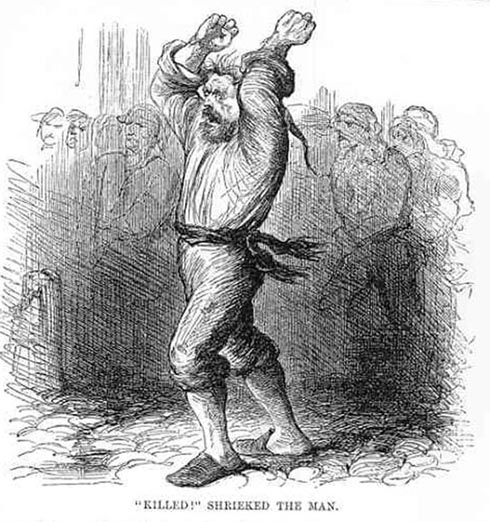"Killed!" shrieked the man.
John McLenan
8.5 cm high (exclusive of caption) by 8.5 cm wide (3 ⅜ inches square).
Dickens's A Tale of Two Cities, Book II, Chapter VII, "Monseigneur in Town"
Harper's Weekly (2 July 1859): 421; this text from the eleventh installment previously appeared a week earlier in the UK in All the Year Round, on 25 June 1859.
[For passage illustrated, see below.]
Passage Illustrated: The Stoppage of a Carriage at the Fountain in St. Antoine
"What has gone wrong?" said Monsieur, calmly looking out.
A tall man in a nightcap had caught up a bundle from among the feet of the horses, and had laid it on the basement of the fountain, and was down in the mud and wet, howling over it like a wild animal.
"Pardon, Monsieur the Marquis!" said a ragged and submissive man, "it is a child."
"Why does he make that abominable noise? Is it his child?"
"Excuse me, Monsieur the Marquis — it is a pity — yes."
The fountain was a little removed; for the street opened, where it was, into a space some ten or twelve yards square. As the tall man suddenly got up from the ground, and came running at the carriage, Monsieur the Marquis clapped his hand for an instant on his sword-hilt.
"Killed!" shrieked the man, in wild desperation, extending both arms at their length above his head, and staring at him. "Dead!"
The people closed round, and looked at Monsieur the Marquis. There was nothing revealed by the many eyes that looked at him but watchfulness and eagerness; there was no visible menacing or anger. Neither did the people say anything; after the first cry, they had been silent, and they remained so. The voice of the submissive man who had spoken, was flat and tame in its extreme submission. Monsieur the Marquis ran his eyes over them all, as if they had been mere rats come out of their holes.
He took out his purse.
"It is extraordinary to me," said he, "that you people cannot take care of yourselves and your children. One or the other of you is for ever in the way. How do I know what injury you have done my horses. See! Give him that."
He threw out a gold coin for the valet to pick up, and all the heads craned forward that all the eyes might look down at it as it fell. The tall man called out again with a most unearthly cry, "Dead!" [Book the Second — "The Golden Thread," Chapter VII, " Monseigneur in Town," 421]
Commentary
Compare McLenan's handling of this emotionally fraught scene with that of Dickens's serial illustrator for the monthly serialisation, Hablot Knight Browne, The Stoppage at the Fountain (August 1859). The Marquis considers two alternatives for coping with this temporary inconvenience: his sword and his purse. Whereas Phiz provides a panoramic treatment of the accident occasioned by the heedless speed of the Marquis' coach through the congested streets of St. Antoine, McLenan moves in for the closeup, focussing on the distraught father. McLenan would not have seen Phiz's August steel-engraving, and, owing to copyright considerations, the English illustrator undoubtedly would not have seen this principal illustration of the 2 July number in Harper's Weekly.
Other Illustrated Editions (1859-1910)
- Hablot K. Brown or 'Phiz'. No. 3 August: A Discussion of the August 1859 Plates
- Sol Eytinge, Junior (8 illustrations, 1867)
- Fred Barnard (25 illustrations, 1874)
- A. A. Dixon (12 illustrations, 1905)
- Harry Furniss (32 illustrations, 1910)
Related Material
- John McLenan's Thirty-One Headnote Vignettes for A Tale of Two Cities in Harper's Weekly (7 May — 3 December 1859)
- Phiz's June 1859 Plates for Dickens's A Tale of Two Cities
- French Revolution
- Victorian Images of the French Revolution
- "A Tale of Two Cities (1859): A Model of the Integration of History and Literature"
Scanned image by Philip V. Allingham; text by PVA and George P. Landow. [You may use this image without prior permission for any scholarly or educational purpose as long as you (1) credit the person who scanned the image and (2) link your document to this URL in a web document or cite the Victorian Web in a print one.]
Bibliography
Allingham, Philip V. "Charles Dickens's A Tale of Two Cities (1859) Illustrated: A Critical Reassessment of Hablot Knight Browne's Accompanying Plates." Dickens Studies. 33 (2003): 109-158.
Dickens, Charles. A Tale of Two Cities. Illustrated by Phiz (Hablot Knight Browne). London: Chapman and Hall, 21 November 1859.
_______. A Tale of Two Cities. Illustrated by John McLenan. Harper's Weekly: A Journal of Civilization, 7 May through 3 December 1859.
_______. A Tale of Two Cities: A story of the French Revolution. Project Gutenberg e-text by Judith Boss, Omaha, Nebraska. Release Date: September 25, 2004 [EBook #98].
_______. A Tale of Two Cities. With illustrations by John McLenan and Rowland Wheelwright. Orinda, Cal.: Sea Wolf Press, 2021.
Victorian
Web
Illustra-
tion
John
McLenan
A Tale of
Two Cities
Next
Created 5 August 2007
Last modified 18 November 2025
